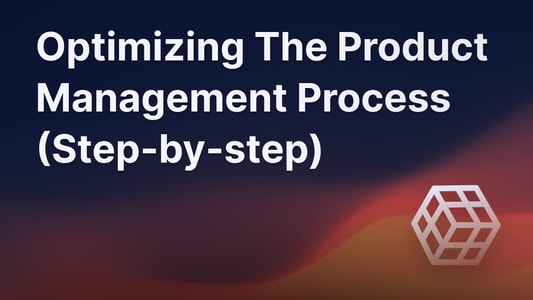Blog Product ManagementWhat does a product manager actually do?
What does a product manager actually do?
Product Managers (PMs) are the all-stars who expertly balance customer wants, market demands, and company goals to create amazing products. In this blog, we'll dive deep into what PMs really do, covering everything from their daily tasks to the secrets of becoming successful in this field.

Over the last decade, the role of a Product Manager, or PM for short, has turned into one of the most desired jobs out there. With an average salary of $157,000 per year in the United States (2024), it's easy to see why so many are interested in this career choice.
But what do Product Managers do? What are the day-to-day responsibilities, and what does it take to become a great PM?
If you've ever wondered about the magic behind successful products, stay tuned. We'll cover everything you'd need to know to be a successful Product Manager.
What is the role of a product manager?
A Product Manager navigates a product all the way from an initial concept to its launch in the market.
PMs are expected to work very closely with different teams – like engineering, design, and marketing – to bring a product to life and tweak it accordingly.
They're the ones laying out the roadmap, deciding which bugs or features to prioritize, and making sure the end product actually solves problems for its users.
But that's not all. PMs also spend a lot of time understanding the market and their customers. They're constantly gathering feedback, analyzing data, and tweaking their strategy to ensure the product hits the mark.
In short - they lead, plan, collaborate, and adjust, all to launch products that meet real needs. It's a role that's as challenging as it is rewarding, and it's clear why those who excel in it are highly valued.
The responsibilities of a product manager
The responsibilities of a Product Manager are both broad and critical to a product's success.
Let's break down five key reasons why they are essential:
1. Defining the Vision and Strategy
A Product Manager starts by setting a clear direction for the product.
This isn't just about having a good idea; it's about crafting a vision that inspires and guides the entire team. They visualize the future of the product and lay out a strategy to get there. This involves:
- Identifying the product's core value proposition.
- Mapping out key milestones and objectives to achieve the vision.
Having a well-defined strategy ensures that every effort is aligned with the end goal, keeping the team focused and motivated.
2. Understanding the Customer
At the heart of a Product Manager's role is a deep understanding of the user. They go beyond basic demographics and dive into the needs, wants, and pain points of their target audience. This insight comes from:
- Conducting user research and interviews.
- Analyzing customer feedback and usage data using tools like Featurebase.
This knowledge is crucial because it ensures the product and potential features solve real problems and fits into the users' lives in a meaningful way.
3. Prioritizing Features
With endless possibilities, prioritizing becomes a key responsibility.
A Product Manager must decide which features or improvements will deliver the most value. This involves:
- Evaluating the impact versus effort of each feature.
- Making tough calls on what to build now, what to delay, and what to skip.
This prioritization process ensures that resources are focused on work that advances the product's vision and meets user needs effectively.
Check out our recent blog on this topic for a full guide on prioritization frameworks.
4. Collaborating Across Teams
A Product Manager never works in isolation; they're constantly involved in different teams that include engineering, design, marketing, and sales. Their role involves:
- Creating communication between departments.
- Ensuring that all teams are aligned with the product's strategy and goals.
Effective collaboration ensures that the product not only gets built but also finds its place in the market successfully.
5. Adapting to Change
The only constant in the tech industry is change.
A Product Manager needs to be agile, and ready to adjust the product strategy in response to new competitors, market trends, or feedback. This adaptability is key to:
- Staying relevant in a fast-moving market.
- Continuously meeting the evolving needs of users.
Adapting to change helps minimize risks, such as missing out on new opportunities or deviating from what users really want.
In summary, the role of a Product Manager is pretty diverse - requiring a balance of strategic vision, deep understanding of users, decision-making, collaborative leadership, and flexibility.
What does it take to become a great product manager?
Becoming a great Product Manager is about more than just overseeing a product's development and figuring out what to build next.
There is a set of core skills and qualities that make product managers stand out from the crowd. So let's dive into them.

Big-Picture Mindset
Great PMs stand out because they see the larger vision of where the product can go. They're strategic thinkers who can spot opportunities that align perfectly with the company's goals.
This means having a clear direction and the ability to guide the team through the twists and turns of product development.
Deep User Empathy
At the core of every successful PM is a deep understanding of the user.
This isn't just about knowing the demographics but truly getting into the users' heads.
It's about engaging with them, listening to their feedback, and using those insights to advocate for features and improvements that genuinely enhance their experience.
Effective Communication
The ability to communicate clearly and effectively is another important part of becoming a great PM.
This basically involves articulating the product vision to stakeholders and team members, ensuring everyone is on the same page.
It also means fostering an environment where open dialogue is encouraged, helping to prevent misunderstandings and keep the project moving smoothly.
Data-Driven Decision Making
In the world of product management, decisions need to be backed by data.
This means using tools like Featurebase to collect feedback and prioritize based on factors like upvotes, revenue potential, and other metrics.
Great PMs dive into analytics to understand user behavior and preferences. They use these insights to prioritize features and make adjustments, ensuring the product meets market needs and stays ahead of the competition.
Flexibility and Resilience
The best PMs are those who can tweak their plans if the data suggests so and don't just follow blindly what the loudest customer shouts.
Leadership
Finally, leadership is what brings a PM's role full circle.
Great PMs lead by example, showing commitment to the product vision and motivating the team to achieve their best. They navigate conflicts, maintain morale, and drive the team toward success with a clear and compelling direction.
Becoming a great PM means blending all these skills and qualities.
It's about leading with vision and empathy, making informed decisions, communicating effectively, and adapting to change, all while keeping the team aligned and motivated. It's a challenging role, but for those who excel, it's incredibly rewarding.
How will AI impact the product management role?
As the rapid progress of AI continues, it's natural to wonder about the future of the product management role.
Will AI replace PMs, or will it serve as a tool to enhance their capabilities?

For starters, AI's ability to analyze massive amounts of data can provide insights that were previously impossible to uncover.
This means PMs can make more informed decisions, backed by data, about everything from user preferences to potential market shifts.
Moreover, AI can automate repetitive tasks, such as sorting through user feedback or conducting A/B tests.
This doesn't mean AI is taking over these aspects of the job; rather, it's freeing up PMs to focus on more strategic and creative tasks that require human insight and empathy—qualities that AI cannot replicate.
One of the most significant advantages of AI is its potential to personalize the user experience.
By understanding individual user behaviors and preferences, AI can help create products that are more closely aligned with what users want, sometimes even before they know they want it.
This level of personalization is something PMs could only dream of achieving at scale just a few years ago.
In conclusion, rather than worrying about AI replacing them, PMs should view AI as a powerful ally that can enhance their work.
By automating routine tasks and providing deeper insights, AI allows PMs to focus on the core aspects of their role that require a human touch. As the landscape evolves, staying informed and adapting to new tools and technologies will be key for PMs to thrive.
How could I learn more about product management?
There are so many resources out there for product managers that it can be overwhelming to find where to start.
To avoid the generic recommendations, here are some of the best resources to date that we have found and are fans of:
1. Lenny's podcast

Lenny has an exceptional podcast with weekly appearances of world-class product managers from companies like Meta, Atlassian, Netflix, and OpenAI, which helps you really get a deep understanding of the topic.
It's a great starting point to get actionable advice for what it takes to be a stand-out PM and find out about the inner tips of the industry.
Check it out from here.
2. The Linear blog

Linear is one of the most innovative software and product teams out there and is a great example to learn from to stand out from the crowd.
They take a very opinionated approach to their product management process and have great write-ups in their blog about how they plan for work, think about feature development, and prioritize customer requests.
Check it out from here.
3. Read the fundamental books
Books are another great way to deepen your understanding of the topic.
Classics like "Inspired: How to Create Products Customers Love" by Marty Cagan and "Lean Startup" by Eric Ries offer timeless insights into creating successful products.
Reading widely not only helps you grasp the principles of product management but also exposes you to different approaches and philosophies.
Check out all of our favorite product management books →
4. Communities
The best way to get great at a topic is to surround yourself with other people and experts who are on the same path.
Platforms like Product Hunt, Reddit’s r/ProductManagement, and Slack communities are places where you can ask questions, share experiences, and get advice from fellow PMs.
These communities are also great for staying updated on industry trends and networking.
Summing it up
Product managers are the backbone of any successful company. They guide ideas into reality and ensure that what lands in the market truly resonates with users.
It’s a role that blends strategic planning, deep user understanding, and the ability to pivot at a moment's notice – making it both challenging and incredibly rewarding.
To make your job easier as a product manager, consider product management tools like Featurebase. These tools streamline many aspects of product management, from gathering user feedback to prioritizing development tasks, helping you stay on top of your game.
Simplify product management with Featurebase →
Whether you're just starting out or are on the path to refining your skills, the journey in product management is rich with chances to impact and innovate.
The simple feedback tool with feature voting for your customer feedback. Built-in the 🇪🇺.
© 2024 Featurebase. All rights reserved.



